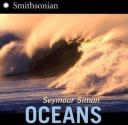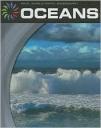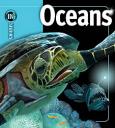The ocean is always a fun topic for students to study. In fifth grade, the ocean’s environment is investigated. The resources below focus on the physical characteristics of the ocean (SOL 5.6b). There are sources that highlight salinity, currents, and the depths of the ocean water. These resources are intended to help deepen students’ understanding of the vast ocean and its components.
Text Annotations
Oceans by Seymour Simon is a great book to introduce ocean characteristics to fifth graders. As Simon points out, 70% of the earth’s surface is covered by one big ocean. In the book, the moon’s power over the tides is demystified while different types of waves are explored. Through its beautiful satellite and computer enhanced pictures and kid-friendly text, Oceans is a great resource for students and teachers alike.
Eyewitness Books: Ocean by Miranda MacQuitty and photographed by Frank Greenaway is an extensive and highly comprehensive look at the ocean and its amazing characteristics. Thirty two subjects are visited in two page layouts, including sea meadows and seabeds. Great explanations about waves, weather, sea temperatures are included with pictures, photos, graphs, and pertinent text. Salinity is addressed while ocean depths are charted out with a colorful simulation graph. As aforementioned this book really examines many aspects of the ocean’s environment. This is a must read.
Oceans by Ann Heinrichs examines the physical characteristics of the ocean. In this thrity-two page book characteristics such as pressure, depths, currents, and tides are highlighted. Heinrich analyzes these characteristics through a mathematical point of view. Oceans examines why these characteristics are not only important to the ocean but to the planet as well. Heinrichs combines the explanations of the ocean’s pressure, depths, and currents with the examination of environmental concerns. The reading and comprehension level is appropriate for fifth grade students.
Insiders Ocean (The Insider Series) by Beverly McMillan and John A. Musick. This visually stunning book contains fun ocean factoids. The books is split up into three main categories: A Watery World, Ocean Life, and Exploring the Oceans. The first section is especially important when studying ocean characteristics. This section has spreads on underwater landscapes, ocean in motion, and ocean climates. Readers young and old alike will enjoy both the stunning visuals as well as the interesting information provided.
Did you know that there are mountains under the ocean? Science Files: Oceans by Anita Ganeri anwsers this question and many more relating to the ocean. Everything from currents to the ocean’s ecosystem is covered by the award-winning author. Ganeri provides bonuses such as a website page as well as an “Amazing facts” page in order to entice students further in their ocean investigation. Within the thirty-two pages, the ocean’s physical characteristics are covered in this dynamic format.
Web Annotations
Current Capers
This BBC interactive website is great for letting students explore the ocean’s currents and the animals who take advantage of those currents. A map with moving currents is shown and the point of the game is to guess where certain animals will go along those currents. It is a fun way to get students to think about how the currents effect ocean animals and their migrations.
Ocean Zones
This site is part of the Extreme Science website. This website will allow students to explore the different zones and depths of the ocean. The depths are split up into four zones: Sunlight, Twilight, Midnight and Deep Sea Trench Zone. The depths (in meters) and the characteristics of each zone are investigated. In the Twilight, Midnight and Deep Sea Trench Zone sections, there are videos to accompany the text and picture visuals. Students will enjoy comparing and contrasting the different depths and exploring the characteristics and creatures that live at each zone.
Motion in the Ocean
This site is apart of the Discover Channel website. “Motion in the Ocean” explores ocean currents (Gulf Stream) while explaining the currents and its effect on salinity and temperature of different parts of the ocean. Along with a great description, a 3D globe is used to show the warm and cool currents as well as displaying temperature through color coding. the globe can be manipulated in order to see different currents at different parts of the globe. Not only is this website extremely helpful in explaining currents but also helps show the co-dependency of the ocean’s physical characteristics.
Ocean: Salinity and other Characteristics
This website offers a great explanation of the salinity of the ocean water. The text might be challenging for some but the information is incredibly useful. At the bottom of each page there is an arrow. This arrow will lead students to explanations about water pressure, temperature and, density. There is also a quiz at the end for students to check their understanding of the information provided within the site.
Climate Kids: What is happening in the ocean?
This NASA kids website allows children to put the oceans characteristics into perspective. This website poses and answers about the oceans Conveyor Belt and salinity and their effects on the plant’s climate. The text is easy to understand while covering the important points in relation to the ocean’s water. The relationship between currents and salinity are also highlighted. This website is a good way to put the ocean water’s characteristics into context.
Additional Resources for Teachers
Ocean Currents Lesson Plan
This website provides a quick lesson plan, including two demonstrations, about the ocean currents. The lesson plan includes currents information pertinent to the demonstrations This lesson plan is appropriate for grades 3-6.
Guide to Oceans
“Guide to Oceans” is a great resource for background information and handouts. The website includes a series of websites concerning ocean water. There is also writing summary handouts about oceans and other related resources links.
Water Temperature
The National Ocean Service Education website has many good sites about the ocean and its physical characteristics. The “Water Temperature” website provides great information about the relationship between temperature of water and oxygen levels. The site also has good animation that simulates how increasing temperature affects the concentration of oxygen in water.
Understanding Density and Salinity Lesson Plan
This is a great lesson plan/ experiment in order to teach fifth graders about density and salinity. This lesson will help students understand that density causes a liquid to be heavier and that dissolved minerals cause the density of the liquid to be greater.





